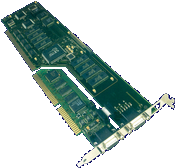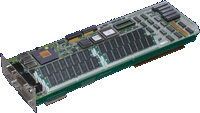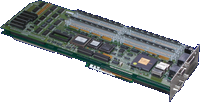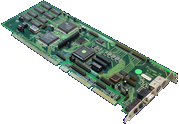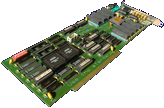Search Result
17 expansions found
Manufacturer Commodore, USA | Date 1991 | Amiga A2000, A3000, A4000 | Interface Zorro II | Autoconfig ID 1030 / 01004 / 245 |
- RTG graphics card
- Texas Instruments TMS34010 @ 50 MHz
- 2 MB RAM, sixteen 1M×1, 100 ns ZIP VRAMs
- 1 MB video frame buffer, 0.75 MB program overlay, 0.25 MB overlay bitplanes
- screen modes
- 256+3 colours from a 24 bit palette
- screen modes - only two is available one time by installing the appropriate oscillators
- 14.318 MHz - 512×512 interlace, quad buffering
- 14.318 MHz - 640×400 interlace
- 36 MHz - 800×600 non-interlace (default)
- 44.9 MHz - 1024×768 interlace
- 48 MHz - 1024×768 interlace
- 67.88 MHz - 1024×768 non-interlace (default)
- 80 MHz - 1024×1024 interlace
- default is 800×600 and 1024×768 non-interlaced
- software switching between the two clock sources
- notes
- RS343 compatible video sync on green and / or separate TTL sync
- programmable synchronization timing
- HD15 connector
- no video passthrough
- originally built for A3000UX machines
- intended to use its not very well developed TIGA system
- CyberGaphX 2, 4.2 and EGS drivers
- supported by NetBSD (except for X server) and OpenBSD
- A2410_HWSW_Overview.pdf
A2410 Hardware/Software Overview
162 kB
- EGSA2410Classi.lha
Aminet
EGS driver v1.14
214 kB - a2410publickey.lha
Aminet
EGS public keyfile
2 kB - a2410src.lha
Aminet
TIGA Workbench
182 kB
Manufacturer Phase 5 Digital Products, Germany | Date 1996 | Amiga A2000A3000, A4000 | - - | Interface Zorro IIZorro III, video slot | Autoconfig ID 8512 / 678512 / 50 |
- RTG graphics card
- S3 ViRGE (PCI bus)
- 135 MHz dot clock in 8 bit modes
- 80 MHz @ 16 bit
- 50 MHz @ 24 bit
- 64 bit blitter
- complex 3D functions
- 25 MHz local PCI bus
- 4 MB 64 bit page mode DRAM, eight chips
- screen modes
- programmable resolutions
- 1600×1200×8 non interlace
- 1280×1024×16
- 1024×768×24
- optional modules
- monitor switch & scan doubler
- allows using one monitor for Amiga and CyberVision modes
- doubles native Amiga 15 kHz modes to 31 kHz
- connects to the video slot in one line with the CyberVision
- a small ribbon cable attaches the cards
- HD15 VGA connector
- MPEG decoder
- realtime MPEG audio and video decoding in full size or in a Workbench window
- dedicated line output jack
- notes
- Zorro II / III autosensing
- HD15 connector
- CyberGraphX 3, 4 and Picasso96 drivers
- supported by Linux and NetBSD
- CyberVision643D.pdf
DCE
user manual (german/english)
194 kB
- CyberVision64_3D-20.dms
install disk v2.0
cgxsystem.library 41.0beta20
CVision3D 2.0beta335 (22.12.96)
550 kB - CyberVision64_3D-21.dms
Install disk v2.1
cgxsystem.library v41.1, CVision3D v2.1 (3.2.97)
526 kB - CyberVision64_3D-30.dms
install disk v3.0
cgxsystem.library v41.9, CVision3D v2.10 (20.6.97)
525 kB - CV3DInstall.lha
Aminet
install disk
1042 kB
Prototype
Manufacturer Phase 5 Digital Products, Germany | Date 1996 | Amiga A2000A3000, A4000 | - - | Interface Zorro IIZorro III, video slot | Autoconfig ID 8512 / |
- RTG graphics card
- S3 ViRGE (PCI bus)
- 25 MHz local PCI bus
- 4 MB 64 bit page mode DRAM, eight chips
- programmable resolutions
- Zorro II / III autosensing
- HD15 connector
Manufacturer X-Pert Computer Services / Village Tronic, Germany | Date 1992 | Amiga A2000, A3000, A4000 | Interface Zorro II | Autoconfig ID 2162 / 1,22167 / 1,2 |
- RTG graphics card
- the card has a standard ISA connector with a PC display card plugged into it
- Tseng Labs ET4000
- 1 MB RAM
- six predefined screen modes
- 1280×1024 87 Hz interlaced, up to 16 colours from a 18 bit (262144) palette
- 1152×900 60 Hz, up to 256 colours from 18 bit
- 1120×832 65 Hz, up to 256 colours from 18 bit
- 1024×768 70 Hz, up to 256 colours from 18 bit
- 800×600 72 Hz, up to 32768 colours from a 15 bit (32768) palette
- 640×480 81 Hz, up to 32768 colours from 15 bit
- notes
- socket for monitor switcher
- video passthrough connector
- HD15 VGA connector
- CyberGraphX 2, Picasso96, EGS and custom drivers
- supported by NetBSD and OpenBSD
- Domino-ADPro.dms
ADPro tool disk
10 kB - Domino-System-24.dms
system disk (village.library v2.4)
39 kB - Domino-System-25.dms
system disk (village.library v2.5)
195 kB
Manufacturer Great Valley Products, USA | Date 1992 | Amiga A2000 |
- RTG graphics card
- Inmos G364 CLT-RAMDAC
- 110 MHz pixel clock in 24 bit modes
- up to 80 kHz horizontal frequency
- up to 140 Hz vertical frequency
- 4 or 8 MB VRAM - 25 ns serial access, 80 ns random access
- the VRAM can be directly accessed by the 68030 or 68040 on the host Combo card
- eight SIMM sockets accept only special 1 MB GVP VRAM-SIMMs in groups of four
- 64 bit interleaved VRAM access
- up to 440 MB/s graphics data bus bandwidth with interleave
- max 576 MB/s blockwrite data bandwidth
- 50 MB/s CPU bus bandwidth - higher in burst mode
- double buffered true colour animations at 720×480 with 318 frames per second
- 64×64 pixels built-in hardware cursor
- screen modes
- 1600×1280×24
- 3200×2560×8
- notes
- connects to GVP G-Force Combo accelerators' 32 bit local bus
- HD15 VGA connector
- output control connector (mini DIN) for external monitor switch boxes
- external composite video (blackburst) input (SMB connector) allowing the board's output to be synchronised with an external video signal
- five BNC connectors
- EGS driver
Manufacturer Great Valley Products, USA | Date 1993 | Amiga A2000A3000, A4000 | - - | Interface Zorro IIZorro III | Autoconfig ID 2193 / 1,2 |
- RTG graphics card
- Cirrus Logic GD5426 or GD 5428 (VL bus)
- 85 MHz in 8 bit modes
- 45 MHz in 16 bit
- 28 MHz in 24 bit
- 15-75 kHz horizontal frequency
- up to 200 Hz vertical frequency
- 1 or 2 MB 70 ns DRAM
- four 512 kB chips in SOJ package
- screen modes
- 1600×1280×8 interlace
- 1152×864×16 interlace
- 800×600×24 non-interlace
- notes
- video signal passthrough, automatic monitor switching
- HD15 output and RB9 input connectors
- Zorro II / III autosensing
- does not work reliably with Buster rev. 9 - the Zorro II force option can be enabled in this case
- Picasso96, CyberGraphX 2, 3 & 4 and EGS drivers
- supported by Linux, NetBSD and OpenBSD
Manufacturer DKB, USA | Date 1997 | Amiga A2000 |
- RTG graphics card
- Cirrus Logic GD5446 (PCI bus)
- 135 MHz dot clock in 8 bit modes
- 85 MHz in 16 and 24 bit modes
- 4 MB 45 ns EDO RAM
- screen modes
- 1600×1280×16 interlace
- 1280×1024×24 non-interlace
- notes
- CyberGraphX 3 & 4 drivers
Manufacturer X-Pert Computer Services / Prodev, Germany | Date 1993 | Amiga A2000A3000, A4000 | - - | Interface Zorro IIZorro III | Autoconfig ID 2117 / 3,4,201 |
- RTG graphics card
- Tseng Labs ET4000W32
- 85 MHz dot clock in 8 bit modes
- Brooktree Bt482 RAMDAC with hardware cursor
- 2 or 4 MB DRAM
- although the Merlin was advertised to support 8 or 16 MB, that would be possible with ET4000W32i or ET4000W32p chips only
- only 2 MB is possible in Zorro II mode
- two SIMM sockets for custom made SIMMs
- 1× 2 MB, 32 bit (labeled as "2 MB 32 Bit")
- 2× 2 MB, 16 bit (labeled as "2 MB")
- 1× 4 MB, 32 bit, 60 ns
- the clock speed of the blitter and memory can be selected with jumpers between 50-65 MHz (55 MHz is the default setting)
- optional video module, X-Calibur (
- activates the S-VHS and Composite output connectors
- provides RGB, S-VHS and Composite inputs on a separate slot cover
- the RGB input is fake - the signal is converted to NTSC Y/C and then digitized
- the ProDev digitizing software supports the Composite input only
- provides up to 800×600 @ 16 bit
- works only in Zorro II mode because the ET4000W32 does not support digitizing in its 32 bit mode
- a switch is provided for easy switching between Z2 and Z3 modes (connects to the Z2/Z3 jumper)
- notes
- a genlock module was developed but never sold
- the design of Merlin was not finished when the card went into production, leading to many problems
- compatibility problems with other Zorro cards
- incompatibility with 060 processors
- incompatibility with all GVP processor cards
- reset problems
- the small registers of the ET4000 chip led to problems with 24 bit screens larger than 680×576 (8 and bit screens have no problems)
- X-Pert and ProDev both offered fixes but only ProDev's methods could cure all problems
- Ingenieurbüro Riedel still offers fixing of problematic Merlin cards
- HD15 VGA connector
- S-VHS, RGB, F-BAS output connectors
- automatic monitor switch and video pass through
- every Amiga graphics function is supported except the Copper
- if more than one screen is opened the next one can be seen through a window on the foremost screen
- Picasso96, EGS and ProBench drivers
- supported by NetBSD and OpenBSD
- merlin-e.pdf
Ingenieurbüro Riedel
merlin hardware fix (incl. 060 fix)
26 kB - merlin.pdf
Ingenieurbüro Riedel
Merlin Umbauanleitung (incl. 060-Fix)
20 kB
- Merlin_ADPro-11.dms
HRG-ADPro driver v1.1
109 kB - Merlin_Install-136.dms
install disk v1.36
657 kB - Merlin_Install-144.dms
install disk v1.44
663 kB - Merlin_ProBench-110.dms
ProBench upgrade v1.10
557 kB - Merlin_ProBench-21-1.dms
ProBench upgrade v2.1, disk 1
366 kB - Merlin_ProBench-21-2.dms
ProBench upgrade v2.1, disk 2
580 kB - Merlin_ProBench-22-1.dms
ProBench upgrade v2.2, disk 1
366 kB - Merlin_ProBench-22-2.dms
ProBench upgrade v2.2, disk 2
582 kB - ProBench3-10up.lha
Aminet
ProBench 3.1 update 10
86 kB - ProBench3-9.lha
Aminet
ProBench 3.1 update 9
280 kB
Manufacturer ArMax, Germany | Date 1993 | Amiga A2000, A3000, A4000 | Interface Zorro II, ISA | Autoconfig ID 2181 / 0 |
- RTG graphics card
- basically an ISA to Zorro bridging card, similar to the GoldenGate 2+
- a standard PC display card occupies a second ISA slot
- Tseng Labs ET4000AX
- 1 MB RAM
- six predefined screen modes
- 1280×1024 87 Hz interlaced, up to 16 colours from a 18 bit (262144) palette
- 1152×900 60 Hz, up to 256 colours from 18 bit
- 1120×832 65 Hz, up to 256 colours from 18 bit
- 1024×768 70 Hz, up to 256 colours from 18 bit
- 800×600 72 Hz, up to 32768 colours from a 15 bit (32768) palette
- 640×480 81 Hz, up to 32768 colours from 15 bit
- notes
- HD15 VGA connector
- Picasso96 and custom drivers
- supported by NetBSD and OpenBSD
Manufacturer Village Tronic, Germany | Date 1993 | Amiga A2000, A3000, A4000 | Interface Zorro II | Autoconfig ID 2167 / 11,12,13 |
- RTG graphics card
- Cirrus Logic GD5426 or GD5428
- 85 MHz in 8 bit modes
- 45 MHz in 16 bit
- 28 MHz in 24 bit
- 1 or 2 MB 45 or 60 ns DRAM
- 1 MB (eight DIPs) soldered to board
- eight DIP sockets for additional 1 MB
- accepts 256k×4 DIPs, 45-80 ns
- screen modes
- 1600×1280×8 interlace
- 1152×864×16 interlace
- 800×600×24 non-interlace
- optional video encoder module - Pablo (
- FBAS and S-VHS outputs
- only PAL compatible
- 15 kHz overload protection
- requires a time base corrector if used with a genlock
- notes
- maps its memory directly into the Zorro II address space - speeds up manipulation of graphics memory but limits the amount of fast RAM to 6 MB
- with 8 MB Zorro II fast RAM the board has to be run in segmented mode - lower performance
- two 15 pin VGA connectors
- automatic passthrough
- Picasso96, CyberGraphX 2, 3 & 4, EGS and PicassoRTG drivers
- supported by Linux, NetBSD and OpenBSD
- PicassoII.pdf
user manual (german)
19.6 MB
- PicassoII-121.lha
Picasso96 install disk v1.21
357 kB - PicassoII-15.dms
install disk v1.5 (27.08.1993)
413 kB - PicassoII-22.dms
PicassoRTG install disk v2.2
554 kB - PicassoII-24.dms
install disk v2.4 (06.06.1996)
595 kB - PicassoII-Install_Last.dms
PicassoRTG bonus disk and developer information
623 kB - PicassoII_MainActor-116.dms
Mainactor install disk
MainActor v1.16 (05.08.1993)
332 kB - PicassoII_Supplementary.dms
supplementary disk
647 kB
Manufacturer Village Tronic, Germany | Date 1996 | Amiga A2000, A3000, A4000 | Interface Zorro II | Autoconfig ID 2167 / 11,12,13 |
- RTG graphics card
- Cirrus Logic GD5428
- 30 MB/s blitter speed
- 85 MHz in 8 bit modes
- 45 MHz in 16 bit
- 28 MHz in 24 bit
- 2 MB 45 ns DRAM in four sockets
- screen modes
- 1600×1280×8 interlace
- 1152×864×16 interlace
- 800×600×24 non-interlace
- optional video encoder module - Pablo
- FBAS and S-VHS outputs
- only PAL compatible
- 15 kHz overload protection
- brightness control
- requires a time base corrector if used with a genlock
- notes
- two 15 pin VGA connectors
- automatic passthrough
- DPMS support
- Picasso96, CyberGraphX 2, 3 & 4, EGS and PicassoRTG drivers
- supported by Linux, NetBSD and OpenBSD
- PicassoII-121.lha
Picasso96 install disk v1.21
357 kB - PicassoII-24.dms
install disk v2.4 (06.06.1996)
595 kB
Manufacturer Village Tronic, Germany | Date 1996 | Amiga A2000A3000, A4000 | - - | Interface Zorro IIZorro III | Autoconfig ID 2167 / 21,22,23,24 |
- RTG graphics card
- Cirrus Logic GD5446 (PCI bus)
- 64 bit blitter
- 180 MB/s fillspeed
- videoscaling with interpolation
- colourroom converting
- picture in picture
- 16 bit digital video port
- 135 MHz in 8 bit modes
- 85 MHz in 16 / 24 bit modes
- 15.5 - 84 kHz horizontal frequency
- 50 Hz interlace - 160 Hz non-interlace vertical frequency
- 4 MB 64 bit 45 ns EDO RAM, eight chips
- screen modes
- 1600×1200×16 interlace
- 1280×1024×24 non-interlace
- integrated flicker fixer
- programmable up to 160 Hz
- 24 bit colourdepth for A4000, 12 bit for A3000 / A2000
- EPROM stores the configuration
- does not pass through native Amiga multiscan and double modes
- optional modules
- Pablo IV video encoder (
 )
)
- S-VHS and CVBS outputs
- supports PAL B/G, PAL I, PAL M, NTSC, NTSC-EIA
- SECAM is not supported
- linear interpolation reduces flickering
- two display sizes: 640×480 and 800×600 - the latter is only available in PAL B / G / I mode
- a time base corrector is required if used with a genlock
- Paloma TV tuner (
 )
)
- three video sources - TV tuner, S-VHS, FBAS
- the tuner supports only PAL B/G or PAL I, it does not support SECAM and NTSC
- the videodecoder supports all standards, so it would be possible to use SECAM or NTSC through the S-VHS or Composite input (using a VCR as external tuner), but...
- the software (PalomaTV) is written PAL only
- monoaural sound decoding only
- no teletext support
- Concierto sound module (
 )
)
- Yamaha OPL3 synthesizer
- 16 bit recording and playback
- 3-44.1 kHz input and output
- MIDI interface
- consists of a main board and an I/O board
- two mini DIN connectors with adaptor cables
- planned modules
- MPEG module
- 3D module
- notes
- Zorro II / III autosensing
- integrated local PCI bus
- flashROM for firmware upgrades
- four channel audio mixer on board: Amiga, line, TV, CD
- audio signal switcher - Amiga and CD-ROM inputs
- DDC2B Monitor Plug'n'Play technology
- DPMS power saving
- 15 pin VGA output
- S-VHS input / output for Pablo IV
- 3.5 mm stereo input / output
- when fitting into an A2000 the flicker fixer must be removed by breaking the card - requires the Denise adapter to avoid this
- no support for draggable screens
- Picasso96 and CyberGraphX 3 & 4 drivers
- supported by Linux and NetBSD
- Concierto_english.pdf
Concierto User Manual (english)
269 kB - Concierto_german.pdf
Concierto User Manual (german)
635 kB - PabloII_english.pdf
Pablo II User Manua (english)l
294 kB - PabloII_german.pdf
Pablo II User Manual (german)
454 kB - Paloma_english.pdf
Paloma User Manual (english)
198 kB - Paloma_german.pdf
Paloma User Manual (german)
229 kB - PicassoIV.pdf
user manual (german)
522 kB
- MainActorPIV.lha
Picasso IV loader/saver for MainActor
19 kB - P4Update-71.lha
Picasso IV flash update v7.1
21 kB - P4Update-74.lha
Picasso IV flash update v7.4
22 kB - P4specials-18.lha
Paloma IV update (p4specials.library v1.8)
11 kB - Pablo-12.dms
Pablo IV install disk v1.2
304 kB - Paloma-13.lha
Paloma IV install disk v1.3
332 kB - PicassoIV.dms
Picasso IV install disk v1.40
474 kB
Manufacturer Ingenieurbüro Helfrich, Germany | Date 1993 | Amiga A2000A3000, A4000 | - - | Interface Zorro IIZorro III | Autoconfig ID 2195 / 5,6 |
- RTG graphics card
- Cirrus Logic GD5426
- 85 MHz in 8 bit modes
- 45 MHz in 16 bit
- 28 MHz in 24 bit
- 1 or 2 MB DRAM
- screen modes
- 1600×1280×8 interlace
- 1152×864×16 interlace
- 800×600×24 non-interlace
- notes
- Zorro II / III autosensing
- automatic passthrough
- two 15 pin DSUB connectors
- S-VHS and FBAS connectors for the optional video encoder module
- early boards may have problems with GVP Combo cards - the memory / bus controller has to be replaced on the Piccolo
- feature connector for connecting the VideoCruncher digitizer card
- Picasso96, CyberGraphX 2, 3, 4, EGS and custom drivers
- supported by Linux, NetBSD and OpenBSD
- Piccolo-1.dms
install disk with PicoPainter v1.3 and loaders for AdPro / ImageMaster, disk 1
EGSAmigaDriver v6.011, egs.library v6.100
357 kB - Piccolo-2.dms
install disk with PicoPainter v1.3 and loaders for AdPro / ImageMaster, disk 2
EGSAmigaDriver v6.011, egs.library v6.100
769 kB - Piccolo-3.dms
install disk with PicoPainter v1.3 and loaders for AdPro / ImageMaster, disk 3
EGSAmigaDriver v6.011, egs.library v6.100
776 kB - piccolo_1of3.dms
Installer's Heaven
install disk 1
739 kB - piccolo_2of3.dms
Installer's Heaven
install disk 2
424 kB - piccolo_3of3.dms
Installer's Heaven
install disk 3
314 kB
Manufacturer Ingenieurbüro Helfrich, Germany | Date 1995 | Amiga A2000A3000, A4000 | - - | Interface Zorro IIZorro III | Autoconfig ID 2195 / 10,11 |
- RTG graphics card
- Cirrus Logic GD5434
- 64 bit blitter
- 110 or 135 MHz in 8 bit modes
- 85 MHz in 16 bit modes
- 45 MHz in 24 bit modes
- 2 or 4 MB 64 bit 70 ns DRAM
- 2 MB (four chips) soldered to board
- four sockets for additional 2 MB
- screen modes
- 1600×1280×8 interlace
- 1280×1024×16 interlace
- 1024×768×24 interlace
- notes
- Zorro II / III autosensing
- Picasso96, CyberGraphX 2, 3, 4 and EGS drivers
- supported by Linux and NetBSD
- PiccoloSD64-1.dms
install disk with PicoPainter v1.3 and loaders for AdPro / ImageMaster, disk 1
EGSAmigaDriver v7.001, EGSPiccoloSD64Driver v7.028, egs.library v7.008
465 kB - PiccoloSD64-2.dms
install disk with PicoPainter v1.3 and loaders for AdPro / ImageMaster, disk 2
EGSAmigaDriver v7.001, EGSPiccoloSD64Driver v7.028, egs.library v7.008
803 kB - PiccoloSD64-3.dms
install disk with PicoPainter v1.3 and loaders for AdPro / ImageMaster, disk 3
EGSAmigaDriver v7.001, EGSPiccoloSD64Driver v7.028, egs.library v7.008
777 kB
Manufacturer MacroSystem, Germany | Date 1992 | Amiga A2000, A3000, A4000 | Interface Zorro II | Autoconfig ID 18260 / 6 |
- RTG graphics card
- NCR 77C22E+
- 90 MHz max pixel clock
- 70 MHz in 8 bit modes
- 25 MHz in 24 bit modes
- 15-75 kHz horizontal frequency
- 50-100 Hz vertical frequency
- 1, 2 or 4 MB DRAM, page mode, segmented, 70-80 ns
- sixteen ZIP sockets
- 1 MB setup: every second socket (1, 3, 5, 7...) is populated with a 256k×4 chip (414256)
- 2 MB setup: every socket is populated by a 256k×4 chip (414256)
- 4 MB setup: every second socket (1, 3, 5, 7...) is populated with a 1M×4 chip (414400)
- screen modes
- 2400×1200×8 interlace
- 1280×1024×16 non-interlace
- 1024×768 non-interlace
- notes
- optional external composite encoder - gives television style video output
- optional video encoder - S-VHS and composite outputs
- HD15 VGA connector
- EGS and RetinaEmu drivers
- supported by NetBSD (except for X server) and OpenBSD
- RetinaDOC_zII.dms
Installer's Heaven
documentation (english)
287 kB
- Retina-10-1.dms
install disk v1.0 including VDPaint v2.5, disk 1 (retina.library v1.0)
350 kB - Retina-10-2.dms
install disk v1.0, disk 2
420 kB - Retina-11-2.dms
install disk v1.1, disk 2
365 kB - Retina-12.dms
install disk v1.2 (retina.library v3.8)
279 kB - Retina-13.dms
install disk v1.2 (retina.library v5.14)
365 kB - Retina-14.dms
install disk v1.4 (retina.library v7.6)
383 kB - Retina-20.dms
install disk v2.0 (retina.library v10.22)
507 kB - Retina-21.dms
install disk v2.1 (retina.library v11.7)
578 kB - Retina-22.dms
install disk v2.2 (retina.library v11.8)
579 kB - Retina-23.dms
install disk v2.3 (retina.library v12.0)
583 kB - Retina-23.lha
install disk v2.3 (retina.library v11.9)
563 kB - Retina.bin
ROM image
32 kB - RetinaTuning.dms
tuning disk (retina.library v11.310)
69 kB - Retina_VDPaint-27.dms
VDPaint v2.7 for Retina Z2
475 kB - Retina-11-1.dms
install disk v1.1 including VDPaint v2.6, disk 1 (retina.library v2.3)
417 kB
Vapourware
Manufacturer DKB, USA | Date 1994 | Amiga A2000, A3000, A4000 | Interface Zorro II |
- No description available.
Do you own this expansion, or have information about it? Please let us know.
Manufacturer X-Pert Computer Services / Viona Development, Germany | Date 1990 | Amiga A2000, A3000, A4000 | Interface Zorro II | Autoconfig ID 2117 / 1,2 |
- RTG graphics card
- Inmos IMS G300C (85, 110 or 135 MHz) programmable RAMDAC and sync generator
- no blitter, line drawing engine, or other general purpose graphics processing capability
- Visiona Paint: 2 MB 20 ns VRAM in 16 ZIP sockets
- Visiona Paint+: 4 MB 20 ns VRAM in 32 ZIP sockets
- screen modes
- maximum resolution is only limited by the amount of VRAM installed
- 24/32 bit: up to 1024×1024
- 8 bit: up to 2048×2048
- 2 bit: up to 4096×4096
- 1 bit: up to 8192×4096
- the resolutions above need 4 MB VRAM - with 2 MB VRAM, the maximum resolution is limited
- maximum horizontal frequency: 80 kHz
- resolutions above 1600×1280 flicker badly
- notes
- Visiona Paint can be converted to a Visiona Paint+ by adding 16 RAM chips and a new control PAL
- the VRAM uses 2 resp. 4 MB in the Zorro II address space:
- limits Zorro II RAM expansions to 6 resp. 4 MB
- the VRAM can be used by the Amiga as memory expansion using Addmem program (Visiona library must not be activated)
- content of the Video RAM can be changed by the CPU and the Video Controller (which accesses the Video RAM with a DMA controller)
- two separate oscillators for PAL and NTSC signals - two additional sockets for eg. SECAM
- 15 pin VGA connector
- five HF-PCB connectors
- supports several Sync options:
- output: separate H-Sync/V-Sync, Composite Sync on H-Sync, Sync-on-Green
- input: external synchronization (on H-Sync) with a TBC possible (needs small hardware expansion)
- EGS driver
- the Visiona, the GVP EGS-110/24 and EGS-28/24 Spectrum were all designed by Hendrik Horak
- DIP switch settings
| Jumper | Description | ON | OFF |
| 1 | Amount of Video RAM | 4 MB | 2 MB |
| 2 | ROM selection | selected | deselected |
| 3 - 6 | reserved | - | - |
| 7 | Video Standard | NTSC | PAL |
| 8 | Interlace setting | Interlace on | Interlace off |
| 9 | not used | - | - |
- Visiona.pdf
Bedienungsanleitung / german user manual
1350 kB
- Visiona_Demos-1.dms
Demos Disk 1
471 kB - Visiona_Demos-2.dms
Demos Disk 2
411 kB - Visiona_Demos-3.dms
Demos Disk 3
589 kB - Visiona_Demos-4.dms
Demos Disk 4
682 kB - Visiona_Demos-5.dms
Demos Disk 5
778 kB - Visiona_Imagemaster.dms
ImageMaster Disk
22 kB - Visiona_Libs.dms
Libs Disk
126 kB - Visiona_System-10.dms
System Disk v1.0
311 kB - Visiona_System-134.dms
System Disk v1.34
310 kB - Visiona_TV-Paint_Demo-18.dms
TV-Paint Demo v1.8
220 kB - Visiona_Tools-13.dms
Tools Disk v1.3
317 kB - Visiona_Tools-134.dms
Tools Disk v1.34
300 kB
 Amiga Hardware Database
Amiga Hardware Database





